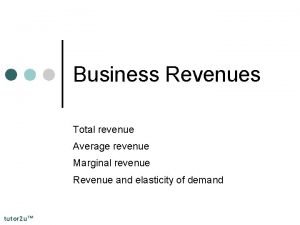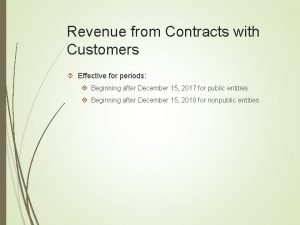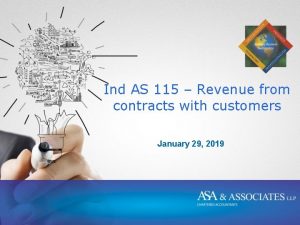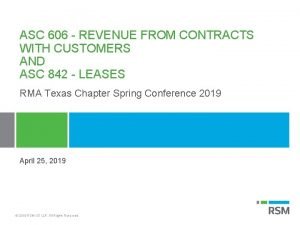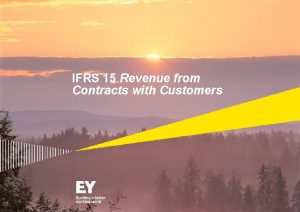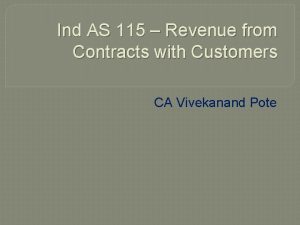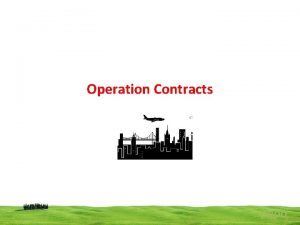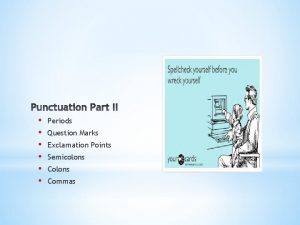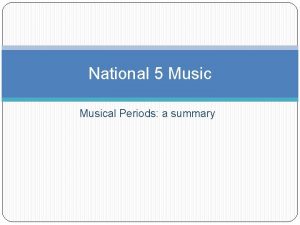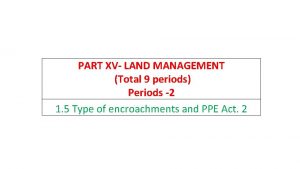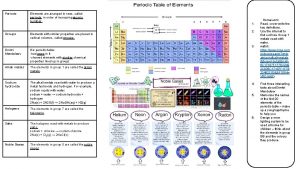Revenue from Contracts with Customers Effective for periods

































































- Slides: 65

Revenue from Contracts with Customers Effective for periods: Beginning after December 15, 2017 for public entities Beginning after December 15, 2018 for nonpublic entities

Applies to: Any entity entering into contracts with customers Does not apply to contracts falling under scope of other standards Examples may include lease or insurance contracts

Changes to Existing Related Standards Summary of Significant Accounting Policies Basis of consolidation Depreciation methods Amortization of intangibles Recognition of revenue from contracts with customers Previously was accounting for recognition of profit on long-term construction-type contracts No longer separate provisions for long-term construction contracts Recognition of revenue from leasing contracts Previously was recognition of revenue from franchising and leasing No longer separate provisions for franchising

Miscellaneous provision The inability to reasonably estimate loss due to uncollectibility or receivables requires recognition under the cost recovery method, the cash basis (rather than the installment method), or some other method.

General Revenue Recognition Provisions Superseded Revenue and gains Installment and cost recovery methods Sale of products, including sales with right of return Sale of services, including Extended warranty and product maintenance contracts Commissions from insurance arrangements Loan guarantee fees In-transit freight service Advertising barter transactions

Multiple element arrangements Rights to use Construction-type and production-type contracts Gains and losses Principal and agent considerations Customer payments and incentives The milestone method

Areas Retained Transactions that do not involve contracts with customers Agriculture – Revenue Recognition, guidance on cooperatives Financial Services – Insurance – Revenue Recognition, guidance on insurance contracts Health Care Entities – Revenue Recognition, guidance on contributions from related fundraising entities and charity care Regulated Operations – Revenue Recognition, guidance on alternative revenue programs

Also Retained: Guidance on dealing with losses (onerous contracts) Revenue Recognition – Provision for losses on separately priced extended warranty and product maintenance contracts Revenue Recognition – Provision for losses on constructiontype and production-type contracts Software – Revenue recognition Financial Services – Insurance – Revenue recognition Contractors – Federal Government – Costs Health Care Entities – Commitments related to continuing care retirement communities Health Care Entities – Contingencies related to prepaid health care services Regulated Operations – Intangibles – Goodwill and Other, related to long-term power sales contracts

Superseded revenue recognition standards Revenue from sale of franchises Revenue from lending and financing activities Allocation of revenue in multiple element arrangements Consideration given by a service vendor to a customer Exchanges of nonmonetary assets for barter credits Reporting of gross amounts by principals and net amounts by agents Revenue from construction-type contracts Revenue recognized by government contractors Internal-use software subsequently marketed

Provisions affected for transactions involving a contract with a customer Sale of leased property Transfer or sale of property, plant, and equipment

Industry Specific Revenue Recognition Guidance Superseded Agriculture – other than cooperatives Airlines Contractors Construction Federal Government Development Stage Entities

Entertainment Broadcasters Cable Television Casinos Films Music Extractive Industries – Oil and Gas

Financial Services Brokers and dealers Depository and lending Investment companies Mortgage banking Franchisors

Health Care Entities - Other than charity care and related fundraising entities Not-for-Profit Entities – Other than contributions Real Estate General Common interest realty associations Real estate investment trusts Retail land Time-sharing activities Regulated Operations – Other than alternate revenue programs Software – Other than provision for losses

Core Revenue Recognition Principle Revenue recognized upon transfer of promised goods or services to customers Amount reflects consideration entity expects to realize in exchange for those goods or services

Five Step Process Identify contract with customers Identify separate performance obligations in contract Determine transaction price Allocate transaction price to separate performance obligations Recognize revenue when entity satisfies performance obligations are satisfied, or while they are being satisfied For products, generally upon satisfaction of performance obligations For services, generally during satisfaction of performance obligations

Step 1 – Identify Contracts With Customers Contract agreement between two or more parties Creates enforceable rights & obligations May be written, oral, or implied by customary business practice No contract if parties cancel without penalty Counterparty must be a customer

Criteria to be considered contract Parties to contract have approved provisions and are committed to perform Rights and payment terms can be identified Contract has commercial substance Collection is probable If criteria met – not reassessed unless significant change in facts or circumstances If criteria not met – reassessed on ongoing basis to determine if criteria are subsequently met

Reassessment If criteria met – not reassessed unless significant change in facts or circumstances If criteria not met: Reassessed on ongoing basis to determine if criteria are subsequently met Consideration received recognized as revenue when either: Entity has no remaining obligations to customer; all, or substantially all, of consideration has been received, and amounts received are nonrefundable; or Contract has been terminated and consideration received is nonrefundable

Consideration Received in Non -contract Situations Recognized as liability until criteria to be considered contract are met or one of conditions for recognizing revenue have been met Liability represents entity’s obligations to provide goods or services or to refund consideration Measured at amount of consideration received

Combining Contracts Principles applied separately to each contract unless combining is appropriate Combined if any of the following apply: Negotiated as a package with a single objective Consideration among contracts interdependent Promised goods or services represent a single performance obligation Criteria may be applied to a portfolio of contracts having similar characteristics

Contract Modifications Change in scope or price approved by parties to the contract May be change order, variation, or amendment May be written, oral, or implied If change in scope approved, but change in price is unknown Change in price estimated using guidance for variable consideration Subject to constraints on estimates of variable consideration

Nature of Modification Separate contract if: Increase in scope due to additional distinct products or services; and Price increases in amount reflective of standalone selling price of additional goods or services

If not separate contract, accounted for as: Termination and replacement Applies if remaining goods or services are distinct from those transferred on or before modification Consideration allocated to remaining performance obligations total of: Consideration from original contract not yet recognized; and Consideration resulting from modification Adjustment to existing contract Applies if remaining goods or services are not distinct, making them part of a single performance obligation that is partially satisfied Adjustment to revenue made in period of modification on cumulative catch-up basis May be a combination

Step 2 – Identify Separate Performance Obligations Performance obligation is enforceable promise to transfer a good or service to a customer Identified at inception of contract Distinct goods or services Series of distinct goods or services with characteristics, including pattern of transfer to the customer Each distinct good or service qualifies as being satisfied over time; and Progress toward completion of each good or service would be measured in the same manner Activities that do not result in transfer of goods or services to customer not a performance obligation

Performance Obligations Include: Sale of goods produced or purchased by the entity Resale of rights to goods or services purchased by the entity Performing an agreed-upon task Being ready to provide a good or service or making goods or services available for use by a customer, at the customer’s discretion Arranging for another party to transfer goods or services to a customer Providing rights to future goods or services to customers that can be resold or provided to their customers Creating an asset on behalf of a customer Granting licenses Granting options to purchase additional goods or services

Distinct Performance Obligations Are distinct if two criteria met: Customer must be able to benefit from it, on its own or using other resources readily available to the customer The good or service can be used, consumed, sold for more than scrap, or used for economic benefit Resources are readily available if sold separately or have already been previously obtained by the customer Promise must be separately identifiable in contract from other promises Based on whether promise is to deliver individual goods or services or a combined item with promised goods or services serving as inputs Other factors indicating promises are separately identifiable: No need for entity to significantly integrate good or service with others that are part of the contract into bundle of services contracted for Other goods or services not significantly modified by good or service Good or service neither highly dependent nor highly interrelated to other goods or services in the contract

Not required to determine if promised goods or services are a performance obligation if not material Entity may elect to consider shipping and handling costs incurred after control of goods are transferred to customer as fulfilling a promise to transfer goods, not a separate promise If not distinct, combined with others until distinct performance obligation results, which may result in a single performance obligation

Warranties May be available for separate purchase by customer Priced or negotiated separately Considered distinct performance obligation May be assurance-type warranting expected performance of goods or services Not available for separate purchase by customer Does not constitute a distinct performance obligation Considered contingent liability Recognized as expense and liability when probable and estimable, generally in period of sale Liability reduced as warranty services provided

May be service-type, providing service in addition to making certain good or service performs as promised Represents distinct performance obligation Examples include: Warranties required by law Warranties extending beyond a reasonable period necessary to evaluate performance Services extend beyond making certain product or services perform as expected May be combination of assurance-type and service-type Allocate revenue between product or service, including assurance-type, and service-type When allocation cannot be reasonably performed, accounted for as service-type

Options for Additional Goods or Services Recognized as distinct performance obligation if rights granted that would not be available to customer if contract not entered into Amount allocated represents payment by customer for future goods or services Recognized as revenue when goods or services subsequently purchased by customer

Step 3 – Determine Transaction Price Amount of consideration to which entity expects to be entitled in exchange for transferring goods or services Excludes amounts collected on behalf of third parties May be gross or net, depending on capacity as principal or agent

Includes consideration of various factors Variable consideration Time value Noncash consideration Consideration given to a customer

Principal versus Agent Considerations Determined by nature of obligation Principal has obligation to provide goods or services Agent has obligation to arrange for another party to provide goods or services To determine if principal or agent Identify goods or services specified in contract Assess whether entity controls goods or services before transfer to the customer Principal controls goods or services before transfer Principal may satisfy performance obligation or engage another to do so Obtaining and immediately transferring of title to customer does not constitute control

Principal has control of one of the following: Goods or assets obtained from another party and transferred to the customer Right to a service to be provided by another party at the direction of the principal Goods or services obtained from other parties to combine with other goods or services to satisfy performance obligation, such as by integrating goods or services provided by another into specified good or service to be provided to customer Principal recognizes gross amount of revenue upon satisfaction of performance obligation

Agent does not control good or service before transfer to customer Indications of control include: Primary responsibility for providing good or service Risk of loss associated with inventory before delivery to customer and after delivery to the customer, such as in the case of a return Discretion in setting price for goods or services

Variable Consideration May result from Discounts or rebates Credits, price concessions, or incentives Performance bonuses Penalties May also result from contingencies Occurrence or nonoccurrence of future event Performance bonus based on achieving a milestone

Considered variable if either: Valid expectation by customer that seller will accept less than contract amount in the form of a discount, rebate, refund, credit, or other price concession; or Facts indicate that seller’s intended, as of the inception of the contract, to make a price concession Estimated at inception of contract using one method on a consistent basis Expected value Most likely amount When receipts exceed amount expected to be retained, difference recognized as refund liability

Constraint on Estimate of Variable Consideration Limits amount of variable consideration to be recognized Must be probable that there will be no significant reversal of the cumulative revenue recognized when the uncertainty is resolved Should consider likelihood and magnitude of potential reversal Factors that increase likelihood or magnitude include: Amount susceptible to factors, such as market volatility, beyond control of entity Uncertainty unlikely to be resolved for long period Unable to reliably anticipate amount due to lack of experience or experience that is not predictive Practice of making price concessions or changing payment terms and conditions Wide range of possible consideration amounts

Reassessment Variable consideration reassessed each reporting period Transaction price adjusted to reflect circumstances as of end of reporting period Accounting for change depends on various factors

Adjustments for Time Value Significant financing component exists when either entity or customer obtains a significant financing benefit May or may not be mentioned in contract Exists when significant time lag between performance and transfer of consideration Factors to consider to determine if financing is significant Difference between amount of consideration and cash price for goods or services Combination of: Time lag between performance and payment Prevailing interest rates

No financing component if any of the following apply: Customer paid in advance and timing of performance is at customer’s discretion Variable component of consideration is significant and contingent on factors outside the control of the customer Difference between consideration and cash price due to factors other than financing and amount is commensurate with factor, such as protection from nonperformance Financing component not required to be measured if time between performance and payment is expected to be one year or less

Financing component Calculated using discount rate appropriate for separate financing transaction between the parties May be calculated as rate that makes present value of consideration equal to equivalent cash price Recognized as interest income or expense, separate from revenues from customers Only recognized to the extent that a contract asset or contract liability is recognized

Contract liability results from customers’ unexercised rights Recognized in amount of prepayments received for unsatisfied performance obligations Nonrefundable prepayments recognized as revenue to extent of breakage, portion not expected to be used If expected, recognized in proportion to pattern of rights exercised by customer If not expected, recognized when likelihood of exercise becomes remote Recognized as liability if required to be remitted to third party

Noncash Consideration Measured at fair value When not determinable, will use reference to standalone selling price of goods or services exchanged When customer contributes resources to assist entity in satisfying performance obligation, if entity obtains control, accounted for as noncash consideration

Consideration Paid to a Customer May be in form of credit, coupon or voucher as well as cash payment May be paid to other party purchasing entity’s goods or services from customer Considered reduction of revenue unless in exchange for distinct good or service If payment exceeds value of distinct good or service, excess reduces transaction price If value of good or service not reasonably estimable, entire payment treated as reduction of revenue Reduction recognized at later of: Recognition of revenue for the transfer of the related goods or services to the customer; or Payment of the consideration to the customer or the promise to do so

Nonrefundable Upfront Fees Must evaluate if compensation for performance obligation Distinct performance obligation when related to transfer of promised goods or services Not considered performance obligation if not related to transfer of promised goods or services, despite being compensation for activity performed near inception of contract May be administrative costs of setting up contract, such as health club membership fee or telecommunication contract activation fee Does not satisfy performance obligation Considered part of total consideration allocated to performance obligations

Sale with Right of Return Revenue recognized in amount expected to be retained, excluding amounts for estimated returns Refund liability recognized for amounts estimated to be refundable based on estimated returns Asset recognized, reducing cost of sales, for right to recover goods from customer

Step 4 – Allocate Transaction Price Allocated to all performance obligations in proportion to standalone selling prices Standalone selling prices as of date of contract inception Amount estimated when standalone selling prices not known Different approaches for estimating standalone selling price Adjusted market assessment Expected cost plus margin Residual approach, usable only when Same good or service sold to different customers at different amounts; or A price has not yet been established for the good or service, which has not previously been sold as a standalone product or service

Allocation of Discounts equal to difference between total of standalone selling prices and total consideration May be allocated to some, but not all performance obligations if all of the following apply: Each distinct good or service in the contract is regularly sold as a standalone good or service; Some of the distinct goods or services are also sold as a bundle at a discount; and Discount in contract is comparable to discount on distinct goods and services sold as a bundle at a discount If allocated to some, but not all performance obligations, residual approach not applied until after discount allocation Otherwise, allocated proportionately among all performance obligations

Allocation of Variable Consideration May be attributable to one or more, but not all, distinct performance obligations, such as a performance bonus related to the timely delivery of a particular good or services May be attributable to one or more, but not all specific goods or services in a series for goods or services forming part of a single performance obligation, such as an annual increase in fees to be paid for a specific service based on changes in a price index. Allocated to a specific performance obligation or good or service if two conditions met: Variable payment attributed to efforts to satisfy the specific performance obligation or transfer the distinct good or service; and Allocating all of the variable consideration to one or more, but not all, performance obligations or goods and services is appropriate to achieve the objectives of the standard Remaining variable consideration allocated to all performance obligations on similar basis as other consideration

Transaction Price Changes Allocated among performance obligations on same basis as allocation of revenues at inception of contract Changes in standalone selling prices not taken into consideration Amounts allocated to performance obligations already satisfied taken into revenue immediately Allocated to one or more, but not all, performance obligations or one or more, but not all goods or services on same basis as variable payments.

Step 5 – Revenue Recognized when performance obligations are satisfied or as they are being satisfied Satisfied when entity transfers promised good or service to customer Transferred when, or as, customer obtains control of goods or services

Customer Control Over Promised Good or Service Various factors considered in determining when customer obtains control Customer has ability to: Direct use of goods or services; Prevent others from benefitting from them; and Obtain benefits from them in the form of cash flows Other factors include: Customer has legal title to asset Entity has transferred physical possession of asset Customer has significant risks & rewards of ownership Customer has accepted asset

Performance Obligations Satisfied Over Time Determined at contract inception if performance obligation satisfied at point in time or over time Satisfied over time if promised good or service is transferred over time Otherwise considered satisfied at a point in time that entity satisfies performance obligation in entirety

Satisfied Over Time One of three conditions met: Goods or services consumed as delivered Customer controls asset during creation or enhancement Asset has no alternative use to seller and seller entitled to payment for performance completed to date Enforceable if customer or other party terminates Reason cannot be for inability to perform Need not be unconditional such as milestone payment Otherwise satisfied at point in time Revenue recognized when customer obtains control

Recognition of Revenue Over Time Based on progress toward satisfying performance obligation May be measured under inputs or outputs approach Inputs measured on the basis of resources used in comparison to total expected to be used Outputs measured on basis of value delivered to customer Updated as circumstances change

Onerous Performance Obligations Lowest cost of satisfying performance obligation exceeds contract price allocated to it Entity recognizes liability & corresponding expense

Licensing Revenue recognized at point in time when license grants right to use intellectual property Property has functionality as is Licensor has no obligation to support or maintain property Performance obligation satisfied when property is available for use

Revenue recognized over time when license grants right to access to intellectual property Intellectual property more symbolic than functional Licensor generally has obligation to support or maintain

Accounting for Costs of obtaining a contract recognized as expense when incurred Certain costs may be recognized as assets Recoverable incremental costs of obtaining a contract Costs required by standards to be capitalized Costs meeting certain criteria

Criteria for Capitalizing Costs Associated with Contracts Costs must meet all of the following three criteria: They relate directly to a contract or a specific contract under negotiation They generate or enhance resources that will be used to satisfy performance obligations in the future They are expected to be recovered

Disclosures – Omitting Those not Required of Nonpublic Entities Contracts with customers Revenues recognized from contracts with customers distinguished from revenues from other sources Impairment losses recognized on receivables or contract losses Disaggregated revenues Categories to depict nature, amount, timing, and uncertainty Relationship of disaggregated revenue information to amounts disclosed for reportable segments Nonpublic entity may elect not to provide quantitative information about disaggregated revenues Will report disaggregation based on timing of transfer of goods and services and provide qualitative information about factors affecting nature, amount, timing, or uncertainty of revenues or cash flows

Performance obligations When performance obligations are typically satisfied, including in bill-and-hold arrangements Significant payment terms Nature of goods or services entity has promised to transfer Obligations for returns, refunds, or other related obligations Warranties and related obligations

Significant judgments, and changes in judgments, made in applying standard Timing of satisfaction of performance obligations If satisfied over time, method used to recognize revenues
 Total revenue
Total revenue Formel för lufttryck
Formel för lufttryck Matte större än tecken
Matte större än tecken Elektronik för barn
Elektronik för barn Borra hål för knoppar
Borra hål för knoppar Mat för idrottare
Mat för idrottare A gastrica
A gastrica Smärtskolan kunskap för livet
Smärtskolan kunskap för livet Bris för vuxna
Bris för vuxna Vad är ett minoritetsspråk
Vad är ett minoritetsspråk Etik och ledarskap etisk kod för chefer
Etik och ledarskap etisk kod för chefer Typiska novell drag
Typiska novell drag Trög för kemist
Trög för kemist Indikation för kejsarsnitt på moderns önskan
Indikation för kejsarsnitt på moderns önskan Rita perspektiv
Rita perspektiv Toppslätskivling dos
Toppslätskivling dos Att skriva en debattartikel
Att skriva en debattartikel Redogör för vad psykologi är
Redogör för vad psykologi är En lathund för arbete med kontinuitetshantering
En lathund för arbete med kontinuitetshantering Lek med geometriska former
Lek med geometriska former Bästa kameran för astrofoto
Bästa kameran för astrofoto Skriven med rytm och rim
Skriven med rytm och rim Offentlig förvaltning
Offentlig förvaltning Mantel som bars av kvinnor i antikens rom
Mantel som bars av kvinnor i antikens rom Orubbliga rättigheter
Orubbliga rättigheter Big brother rösta
Big brother rösta Verktyg för automatisering av utbetalningar
Verktyg för automatisering av utbetalningar Förklara densitet för barn
Förklara densitet för barn Ministerstyre för och nackdelar
Ministerstyre för och nackdelar Sju principer för tillitsbaserad styrning
Sju principer för tillitsbaserad styrning Vem räknas som jude
Vem räknas som jude Tack för att ni lyssnade bild
Tack för att ni lyssnade bild Nyckelkompetenser för livslångt lärande
Nyckelkompetenser för livslångt lärande Sju för caesar
Sju för caesar Informationskartläggning
Informationskartläggning Datumr
Datumr Magnetsjukhus
Magnetsjukhus Stål för stötfångarsystem
Stål för stötfångarsystem Personalliggare bygg undantag
Personalliggare bygg undantag Vishnuiter
Vishnuiter Cks
Cks Inköpsprocessen steg för steg
Inköpsprocessen steg för steg Omprov cellprov
Omprov cellprov Urban torhamn
Urban torhamn Strategi för svensk viltförvaltning
Strategi för svensk viltförvaltning Stickprovsvarians
Stickprovsvarians Datorkunskap för nybörjare
Datorkunskap för nybörjare Tack för att ni har lyssnat
Tack för att ni har lyssnat Läkarutlåtande för livränta
Läkarutlåtande för livränta Treserva lathund
Treserva lathund Returpilarna
Returpilarna Påbyggnader för flakfordon
Påbyggnader för flakfordon Tack för att ni lyssnade
Tack för att ni lyssnade Tobinskatten för och nackdelar
Tobinskatten för och nackdelar Egg för emanuel
Egg för emanuel Atmosfr
Atmosfr Byggprocessen steg för steg
Byggprocessen steg för steg Tidböcker
Tidböcker Rutin för avvikelsehantering
Rutin för avvikelsehantering Biologiska arvet
Biologiska arvet Presentera för publik crossboss
Presentera för publik crossboss Rbk-mätning
Rbk-mätning Formuö
Formuö Myndigheten för delaktighet
Myndigheten för delaktighet Var 1721 för stormaktssverige
Var 1721 för stormaktssverige Tack för att ni har lyssnat
Tack för att ni har lyssnat
